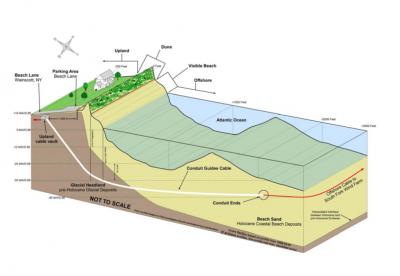Deepwater Dangles Cash Incentives to Town and Trustees

Deepwater Wind, which is planning to construct 15 offshore wind turbines 30 miles east of Montauk, has selected Beach Lane in Wainscott as the best spot for its power cable to come ashore, a representative told the East Hampton Town Board Tuesday. It is offering cash grants for environmental projects, among other sweeteners for the town.
The company examined five potential landing sites and cable routes to carry energy from the turbines to a Long Island Power Authority substation off Cove Hollow Road in East Hampton before identifying Beach Lane as the preferred location.
The cable would travel up Beach Lane and along Wainscott Main Street to reach Wainscott Stone Road and continue north across Montauk Highway to run along the Long Island Rail Road right of way. Installation along that route would minimize traffic and other disruptions, Clint Plummer, Deepwater Wind’s vice president for development, said at a board meeting.
In order to proceed with applications to a host of agencies for needed permits, Deepwater first must forge an agreement with East Hampton Town to install the line in the public road right of way, and with the East Hampton Town Trustees to lay the line, as it comes in from undersea, beneath the ocean beach at Beach Lane
In return, and in addition to payments for the needed easements, Deepwater is offering a “community benefits package,” Mr. Plummer said.
The company would pay to have overhead utility lines in Wainscott along the cable route buried underground — on Beach Lane and a portion of Wainscott Main Street, in an area designated by the town and state as scenic. The work would be completed by utility companies and likely take several years; Mr. Plummer said Deepwater would commit to covering the entire cost.
Deepwater has offered $1 million to East Hampton Town for water infrastructure improvements in Wainscott; $500,000 to the trustees for a marine environment improvement fund, with an additional $100,000 fisheries habitat fund, also to be administered by the trustees; and $200,000 more to the town for sustainable energy and resiliency projects, as identified by the town’s energy sustainability committee.
Offices for Deepwater Wind will be maintained in Montauk for the entire 25-year anticipated life span of the turbines, Mr. Plummer said. The number of jobs that would create has not yet been estimated, he said, in answer to a question from Councilman Peter Van Scoyoc, the supervisor-elect, but Deepwater’s Block Island project, with five wind turbines, for example, requires a permanent, year-round staff of six, with additional employees added intermittently throughout the year.
The company will also continually employ a liaison to the fishing community in Montauk; that role is presently filled by Julia Prince, a former town councilwoman. A local fisherman will be appointed as a representative, as well, Mr. Plummer said, with a name to be announced within a month.
Deepwater will provide periodic reports to the town board and town trustees during the project’s construction phase and afterward, the company representative promised — as often as weekly during the on-land cable installation.
Project design and construction details — a deep dive into some of the facts and logistics surrounding the project’s science and engineering — will be presented by the company’s president and a technical team at an East Hampton Town Trustees meeting on Monday, Mr. Plummer said.
The cable under the beach would be at all times at least 10 feet under the hardpan layer beneath the sand and sediment, the depth of which varies. There would be no construction activity on the beach; a cable vault would be installed about 250 feet from the beach on the Beach Lane roadside.
Cable installation would take place only between Labor Day and Memorial Day, Mr. Plummer said, with drilling for the landing cable at the beach confined to November through March. He proposed a 12-hour workday, with the potential to drill 24 hours a day during January, February, and March. Measures would be taken to contain noise, and the town given the authority to shut down day-and-night work if there are noise complaints. The work at Beach Lane is estimated to take between 10 and 14 weeks, total, and cable installation along the four miles from Wainscott to the LIPA substation to take between 8 and 18 weeks. Both segments of the project could go on simultaneously and be accomplished during one winter season, said Mr. Plummer, but final road repaving would likely take place during a second off-season.
East Hampton Town Supervisor Larry Cantwell asked if the company was discussing accommodations for fishermen who might be dislocated from the offshore turbine site during installation. “We don’t believe that we will be disrupting fishing activity,” Mr. Plummer said.
The wind turbine project has been in the works since 2013, when Deepwater Wind, which developed the wind-farm concept in response to a 2015 request for proposals by the Long Island Power Authority, acquired a lease from the federal government for the offshore bottomland 30 miles east of Montauk. It finalized a contract with LIPA for the project last January.
Applications for all the required federal, state, county, and town permits will be submitted in the first quarter of 2018, Mr. Plummer said, and review and public comment are expected to take two years. Construction could begin in early 2021, with the turbines producing energy by late 2022. The wind farm is expected to produce power equivalent to that used by 50,000 residences
